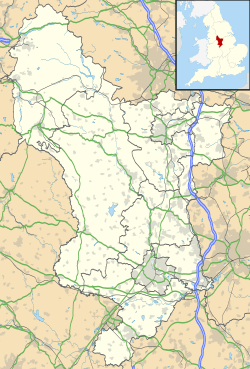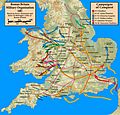Strutt's Park Roman Fort facts for kids
| Location | High Peak, Derbyshire |
|---|---|
| Region | East Midlands |
| Coordinates | 52°55′54″N 1°28′59″W / 52.9317°N 1.4830°W |
| Type | Roman fort |
| History | |
| Founded | 50 |
| Abandoned | 80 |
| Associated with | 3rd Cohort of Bracara Augustani |
Strutt's Park Roman Fort was an ancient Roman army base, or fort, located in Strutt's Park. This area is now a suburb of Derby in Derbyshire, England. The Romans built this fort around the year 50 AD. Later, between 75 and 80 AD, they moved to a new fort called Little Chester. This new fort was just across the River Derwent.
Contents
Where Was Strutt's Park Fort Located?
Today, the old fort site lies beneath Duffield Road and Belper Road. People first reported finding signs of the fort in 1967. In 1995, archaeologists dug up the area. They found flat areas (terracing), stone foundations for walls, and a cobbled path. Some of the pottery found during these digs is now kept at the Trent & Peak Archaeological Trust. Other pieces are at the Derby Museum.
The fort was likely built to protect an important river crossing. Less than a mile south, a major Roman road crossed the River Derwent. This road is now known as Ryknild Street. Two other important Roman roads also started near this spot. One, called The Long Lane, went west towards Wroxeter and Chester. The other, known as The Street, crossed the Peak District towards Buxton and Manchester.
How the Romans Conquered Britain
Historians know a lot about how the Romans conquered Britain in the 1st century AD. But to learn about specific forts like Strutt's Park, they rely on what archaeologists find.
Roman Army Arrives in Britain
The area around Strutt's Park was home to a tribe called the Cornovii. By 46–47 AD, the Roman Army, led by Governor Aulus Plautius, had probably taken control of the lands south of the River Trent.
In late 47 AD, the new governor, Ostorius Scapula, began fighting tribes in the western mountains (modern Wales). Their leader, Caratacus, was defeated in a battle in 50 AD. He then ran away to the Brigantes, a tribe living in the Pennines. The Brigantes' queen, Cartimandua, made a deal with the Romans and handed Caratacus over to them.
Building Strutt's Park Fort
Governor Ostorius died and was replaced by Aulus Gallus. He brought the Welsh border areas under Roman control. It was around this time that the fort at Strutt's Park was built. It was probably located close to the border between Roman land and the Brigantes' territory. The Brigantes were now allies or under Roman rule.
Changes and New Forts
The fight to conquer the Welsh mountains continued under later governors. Around 74 AD, Queen Cartimandua asked for Roman help to stop a rebellion. This showed there might have been trouble in the lands north of Strutt's Park.
Then, in 78 AD, Gnaeus Julius Agricola became governor. He was famous because his son-in-law, Tacitus, wrote a very praising book about him. Agricola made the forts stronger and improved the roads. He also led important campaigns. First, in 78 AD, he took back North Wales. Then, in 79 AD, he conquered the Brigantes and another tribe called the Parisii in modern east Yorkshire. This finished the Roman takeover of what is now northern England.
Strutt's Park Fort was likely built to defend the river crossing against the Brigantes to the north. But after Agricola's conquests, it might not have been needed anymore. Around this time, it was replaced by a new fort at Little Chester. This new fort was right on the line of Ryknild Street and was better placed to control the growing network of Roman roads.
Images for kids
See also
 In Spanish: Fortificación romana de Strutt's Park para niños
In Spanish: Fortificación romana de Strutt's Park para niños



